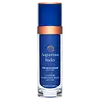What's inside
What's inside
 Key Ingredients
Key Ingredients

 Benefits
Benefits

 Concerns
Concerns

 Ingredients Side-by-side
Ingredients Side-by-side

Water
Skin ConditioningCaprylic/Capric Triglyceride
MaskingCaprylyl Methicone
Skin ConditioningGlycerin
HumectantCetearyl Alcohol
EmollientDimethicone
EmollientGlyceryl Oleate Citrate
EmulsifyingGlyceryl Stearate
EmollientPotassium Olivoyl Hydrolyzed Oat Protein
CleansingPalmitoyl Tripeptide-1
Skin ConditioningPalmitoyl Hexapeptide-12
Skin ConditioningHelianthus Annuus Extract
EmollientAvena Sativa Kernel Extract
AbrasiveTremella Fuciformis Sporocarp Extract
AntioxidantOryza Sativa Bran Extract
Skin ConditioningRosmarinus Officinalis Leaf Extract
AntimicrobialPhospholipids
Skin ConditioningBetaine
HumectantBisabolol
MaskingLinoleic Acid
CleansingTocopherol
AntioxidantGlyceryl Oleate
EmollientCaprylyl Glycol
EmollientGlycine Soja Sterols
EmollientDisodium EDTA
Polyacrylate-13
Polyisobutene
Polysorbate 20
EmulsifyingCaprylhydroxamic Acid
Ethylhexylglycerin
Skin ConditioningPhenoxyethanol
PreservativeWater, Caprylic/Capric Triglyceride, Caprylyl Methicone, Glycerin, Cetearyl Alcohol, Dimethicone, Glyceryl Oleate Citrate, Glyceryl Stearate, Potassium Olivoyl Hydrolyzed Oat Protein, Palmitoyl Tripeptide-1, Palmitoyl Hexapeptide-12, Helianthus Annuus Extract, Avena Sativa Kernel Extract, Tremella Fuciformis Sporocarp Extract, Oryza Sativa Bran Extract, Rosmarinus Officinalis Leaf Extract, Phospholipids, Betaine, Bisabolol, Linoleic Acid, Tocopherol, Glyceryl Oleate, Caprylyl Glycol, Glycine Soja Sterols, Disodium EDTA, Polyacrylate-13, Polyisobutene, Polysorbate 20, Caprylhydroxamic Acid, Ethylhexylglycerin, Phenoxyethanol
Water
Skin ConditioningCoco-Caprylate/Caprate
EmollientHelianthus Annuus Seed Oil
EmollientSqualane
EmollientGlycerin
HumectantArgania Spinosa Kernel Oil
EmollientEthyl Oleate
EmollientPersea Gratissima Oil
Skin ConditioningPolyglyceryl-4 Oleate
EmulsifyingMagnesium Sulfate
Oenothera Biennis Oil
EmollientPanthenol
Skin ConditioningPolyglyceryl-6 Oleate
EmulsifyingZinc PCA
HumectantPolyhydroxystearic Acid
EmulsifyingButylene Glycol
HumectantButyrospermum Parkii Butter
Skin ConditioningPotassium Sorbate
PreservativeSodium Benzoate
MaskingTocopherol
AntioxidantSodium Hyaluronate
HumectantHydrolyzed Rice Protein
Skin ConditioningMaltodextrin
AbsorbentCitric Acid
BufferingCamellia Sinensis Leaf Extract
AntimicrobialHydrogenated Lecithin
EmulsifyingTocopheryl Acetate
AntioxidantXanthan Gum
EmulsifyingAlanyl Glutamine
HumectantArginine
MaskingOligopeptide-177
Phenylalanine
MaskingSisymbrium Irio Seed Oil
MaskingSodium Chloride
MaskingDextran
Palmitoyl Tripeptide-8
Skin ConditioningWater, Coco-Caprylate/Caprate, Helianthus Annuus Seed Oil, Squalane, Glycerin, Argania Spinosa Kernel Oil, Ethyl Oleate, Persea Gratissima Oil, Polyglyceryl-4 Oleate, Magnesium Sulfate, Oenothera Biennis Oil, Panthenol, Polyglyceryl-6 Oleate, Zinc PCA, Polyhydroxystearic Acid, Butylene Glycol, Butyrospermum Parkii Butter, Potassium Sorbate, Sodium Benzoate, Tocopherol, Sodium Hyaluronate, Hydrolyzed Rice Protein, Maltodextrin, Citric Acid, Camellia Sinensis Leaf Extract, Hydrogenated Lecithin, Tocopheryl Acetate, Xanthan Gum, Alanyl Glutamine, Arginine, Oligopeptide-177, Phenylalanine, Sisymbrium Irio Seed Oil, Sodium Chloride, Dextran, Palmitoyl Tripeptide-8
 Reviews
Reviews

Ingredients Explained
These ingredients are found in both products.
Ingredients higher up in an ingredient list are typically present in a larger amount.
Glycerin is already naturally found in your skin. It helps moisturize and protect your skin.
A study from 2016 found glycerin to be more effective as a humectant than AHAs and hyaluronic acid.
As a humectant, it helps the skin stay hydrated by pulling moisture to your skin. The low molecular weight of glycerin allows it to pull moisture into the deeper layers of your skin.
Hydrated skin improves your skin barrier; Your skin barrier helps protect against irritants and bacteria.
Glycerin has also been found to have antimicrobial and antiviral properties. Due to these properties, glycerin is often used in wound and burn treatments.
In cosmetics, glycerin is usually derived from plants such as soybean or palm. However, it can also be sourced from animals, such as tallow or animal fat.
This ingredient is organic, colorless, odorless, and non-toxic.
Glycerin is the name for this ingredient in American English. British English uses Glycerol/Glycerine.
Learn more about GlycerinTocopherol (also known as Vitamin E) is a common antioxidant used to help protect the skin from free-radicals and strengthen the skin barrier. It's also fat soluble - this means our skin is great at absorbing it.
Vitamin E also helps keep your natural skin lipids healthy. Your lipid skin barrier naturally consists of lipids, ceramides, and fatty acids. Vitamin E offers extra protection for your skin’s lipid barrier, keeping your skin healthy and nourished.
Another benefit is a bit of UV protection. Vitamin E helps reduce the damage caused by UVB rays. (It should not replace your sunscreen). Combining it with Vitamin C can decrease sunburned cells and hyperpigmentation after UV exposure.
You might have noticed Vitamin E + C often paired together. This is because it is great at stabilizing Vitamin C. Using the two together helps increase the effectiveness of both ingredients.
There are often claims that Vitamin E can reduce/prevent scarring, but these claims haven't been confirmed by scientific research.
Learn more about TocopherolWater. It's the most common cosmetic ingredient of all. You'll usually see it at the top of ingredient lists, meaning that it makes up the largest part of the product.
So why is it so popular? Water most often acts as a solvent - this means that it helps dissolve other ingredients into the formulation.
You'll also recognize water as that liquid we all need to stay alive. If you see this, drink a glass of water. Stay hydrated!
Learn more about Water